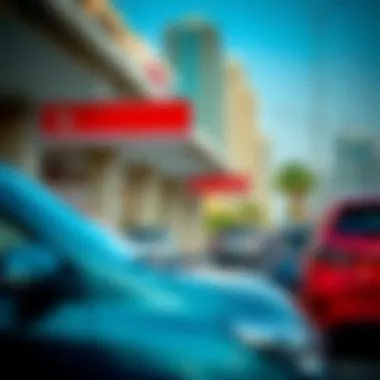RTA Free Parking in Dubai: The Ultimate Guide


Intro
Navigating the hustle and bustle of Dubai can be quite the whirlwind experience. With the city buzzing and the roads often packed, the issue of parking looms large for both residents and visitors. Among the myriad of solutions at one’s disposal, RTA free parking options emerge as a practical and attractive solution to maneuvering the parking landscape of this vibrant city. This guide will peel back the layers of RTA's free parking initiatives, focusing not only on where to find these parking gems but also on eligibility criteria and application processes.
With the ever-expanding urban sprawl of Dubai, understanding these parking facilities holds value far beyond mere convenience. It intertwines with larger themes such as urban mobility and the growth trajectory of real estate development in the city. As we dissect the components of RTA’s offerings, we’ll shed light on how these parking solutions contribute to the overall quality of city living and mobility.
Prelude to RTA Parking in Dubai
Parking in Dubai can be a daunting experience, especially in the bustling areas where the foot traffic seems endless. Having a grasp on the RTA Parking system is essential for anyone navigating this vibrant city, be it a resident or a visitor. Understanding this framework can save time and money and enhance the overall experience of moving around in this sprawling urban landscape.
The Roads and Transport Authority (RTA) provides a structured and efficient parking system, with various options available to cater to the different needs of users. Free parking is a boon, particularly in populous areas where paid parking can add up quickly. Knowing where these free parking zones are located becomes a valuable asset, allowing individuals to make informed decisions on how they navigate their parking needs.
Not only does understanding free parking zones alleviate some of the stress associated with looking for a spot, but it also sheds light on broader themes of urban mobility and the development of real estate in Dubai. The city is continuously evolving, and with that evolution comes the importance of accessible parking solutions. As expats and investors eye opportunities in Dubai's real estate market, the RTA parking options can play a crucial role in determining the appeal of specific neighborhoods and districts.
Understanding the RTA Parking System
The RTA parking system in Dubai is comprehensive, with various categories designed to meet different situations. Paid parking can be found in a variety of areas, often associated with malls, business districts, and tourist attractions. However, it's the free parking zones that deserve emphasis, as they provide a much sought-after alternative for individuals conscious of their budgets.
The RTA's approach is not just about providing spaces; it's about managing them effectively to serve the needs of the community. RTA has implemented a user-friendly interface for parking management, including the usage of mobile applications that allow users to locate available parking spaces and receive updates on regulations. This integration signifies a forward-thinking approach to urban planning where technology meets everyday life.
Understanding the nuances of this system makes it easier for residents and visitors to navigate the city, ensuring they are making the most of what Dubai has to offer.
Free Parking: An Overview
Free parking in Dubai presents a breath of fresh air amid a city that often feels like it’s on fast-forward. From strategic locations like public parks to shopping malls and even certain residential areas, these free zones provide a crucial service to both residents and visitors.
Many don’t realize that attractive parking options can also influence foot traffic and economic activity in a given area. For example, areas with ample free parking often see an uptick in visitors, translating into more business for local shops and cafes. It’s not just about finding a spot; it’s about being part of a thriving community.
While the convenience of free parking is evident, it does come with its own set of considerations. Different zones have varying rules about timing and duration. Staying informed about these changes helps avoid unexpected fines and provides a smoother parking experience.
Free parking not only enhances individual experiences but also plays a significant role in the economy.
Types of Free Parking Areas
Understanding the various types of free parking areas in Dubai is crucial for both residents and visitors navigating the bustling city. Each type of parking area serves a unique purpose and caters to different needs. Knowing where to find these options can significantly alleviate parking stress, especially in a city where spaces can often feel like precious gems.
Public Parks and Recreational Spots
Public parks and recreational spots often feature designated free parking areas. For instance, Al Safa Park, located near the heart of the city, provides ample free parking for families and visitors seeking a day out. It not only helps ease congestion around popular parks but also encourages the use of outdoor spaces.
When heading out for a picnic or a leisurely walk, knowing that parking will not come at a cost can truly enhance the experience. Here’s a brief look at some key points:
- Accessibility: These spots are usually designed for easy access to various facilities, making it convenient to park and enjoy the park's offerings.
- Family-Friendly: Many parks attract families and groups, making adequate parking essential to ensure safety and enjoyment.
- Promoting Green Spaces: Free parking supports the vision of sustainability by drawing attention to public spaces and encouraging outdoor activities.
Shopping Malls and Commercial Districts
Shopping malls and commercial districts are often beacons of activity, and the inclusion of free parking is a significant draw for shoppers. Malls like Mall of the Emirates offer extensive free parking facilities, sometimes even for hours. The convenience of not having to pay for parking can make the shopping experience considerably more enjoyable. Here are some points to consider:
- Visitor Volume: High foot traffic necessitates free parking, making it imperative for malls to adopt these facilities to accommodate everyone.
- Encouraging Longer Visits: Free parking means shoppers are likely to spend more time browsing and exploring.
- Promotional Events: Many malls use free parking during special events or holidays to increase visitor numbers, benefiting both the mall and the shoppers.
Residential Areas with Designated Free Parking
In many residential neighborhoods, free parking is a vital aspect of community living. Areas like Jumeirah and Al Barsha implement designated free parking zones, significantly alleviating the pressure on residents who might otherwise struggle to find a spot. It’s not just beneficial; it’s a key component of community planning. Here’s how:
- Facilitates Community Engagement: Residents are more likely to host gatherings or events without the worry of parking constraints.
- Enhances Property Value: Properties in areas with designated free parking often see better demand as it’s a sought-after feature.
- Balancing Commercial and Residential Needs: Thoughtful planning of parking spaces can ensure that free parking serves both residential needs and commercial undertakings in the area.


Eligibility Criteria for Free Parking
Understanding who qualifies for free parking in Dubai is more than just knowing the basics; it determines how both residents and visitors navigate the city’s bustling landscape. This guide aims to untangle these criteria, shedding light on how they impact day-to-day activities and parking strategies.
Who Can Access Free Parking?
The eligibility for free parking is segmented into a few distinctive categories. Generally, the following individuals can tap into these free parking options:
- Residents holding a valid UAE residency visa.
- Employees with work permits can avail free parking in specific areas.
- Visitors accessing public spaces like parks, where designated free parking is provided.
For instance, residents of developments within the waterfront areas may discover that certain parts of Dubai Marina offer complimentary parking on weekends. Those with government-issued permits can often find designated spots across multiple neighborhoods, making access a breeze.
It's essential to keep in mind that while free parking can provide considerable savings, understanding the accompanying rules and regulations is crucial to avoid any unintended penalties. Parking may seem straightforward, but it’s crucial to take notice of signage and local parking regulations as they can vary from one district to another.
"Access to free parking is not merely a convenience; it enhances overall urban mobility and accessibility for various community members, fostering engagement within the city."
Resident vs. Visitor Considerations
When drawing the line between residents and visitors, the implications for free parking access differ notably. Residents often enjoy more substantial benefits. For example, if a resident isn’t careful about their vehicle registration details, they may miss out on extended parking periods available only to locals. This aspect emphasizes the importance of checking eligibility criteria periodically, especially in newer developments, where policies may change quite frequently.
On the flip side, visitors should be aware that free parking is typically limited to specific periods or locations. Often, public parks allow free access during certain hours or days, providing a good opportunity for families to enjoy outdoor activities without worrying about parking fees. Still, it is wise to carry a digital or paper map showing free parking locations to avoid wasting time or encountering frustration.
In summary, both residents and visitors can benefit from free parking, yet their respective strategies and precautions differ. Understanding these nuances allows for smarter planning and better utilization of Dubai’s parking ecosystem.
Regulatory Framework Surrounding Free Parking
The regulatory framework governing free parking in Dubai is a crucial aspect that shapes the city’s parking landscape. Understanding these regulations is not merely about compliance; it reflects a broader initiative to streamline urban mobility, reduce congestion, and manage space efficiently in one of the world’s fastest-growing cities.
Regulations by the Roads and Transport Authority (RTA) cover multiple dimensions, from where free parking areas can be established to the rules regarding parking duration and eligibility. This structure ensures that both residents and visitors can find ample parking spaces while fostering a sense of responsibility among users to adhere to the guidelines.
One of the benefits of this regulatory scheme is that it enables better allocated resources for urban planning purposes. For example, the criteria that determine where free parking can be implemented often consider the proximity to essential services and public transport hubs, ultimately encouraging people to use more sustainable transportation options.
Additionally, keeping these regulations transparent helps reduce disputes over parking rights which can arise in densely populated areas. Thus, understanding the regulatory framework is not just about knowing the rules; it is about appreciating how these rules interplay to create a balanced urban experience.
RTA Policies and Guidelines
The RTA has laid out comprehensive policies and guidelines that govern free parking in Dubai. These policies aim to enhance user experience while ensuring that free parking contributes to broader urban mobility objectives. Some key points include:
- Designated Free Parking Zones: These areas are specified by the RTA and include parks, shopping malls, and certain residential locations. Each zone is carefully assessed for its impact on local traffic and accessibility.
- Parking Duration Limitations: To counteract long-term misuse, many free parking zones come with time restrictions. For example, shoppers might enjoy a two-hour free period, while residential communities may have different arrangements based on their needs.
- Monitoring and Enforcement: The RTA regularly monitors these areas to ensure compliance with their policies. Regular patrols help enforce guidelines and keep the public informed about any changes to free parking conditions.
These policies create a predictable and user-friendly environment, encouraging people to park where and when they are allowed, ultimately reducing illegal parking incidents.
Impact of Regulations on Parking Availability
The ripple effect of these regulations can be seen in how they influence parking availability across the city. When policies are implemented effectively, they directly impact both the supply and demand for parking spaces.
Positive Impacts:
- Increased Compliance: Clear regulations often lead to higher compliance rates among drivers. When people know what to expect, they are less likely to park illegally, freeing up space for legitimate parking needs.
- Efficient Land Use: The establishment of policies focused on usage maximizes the utility of available spaces. By intelligently designing zones based on traffic flow and usability, the RTA ensures that spaces are not just allocated haphazardly but rather in a manner that suits the community's needs.
Potential Challenges:
- Public Awareness: One downside can arise if residents are not adequately informed about the guidelines. In such cases, despite the regulations being effective, parking issues can persist if people are unaware of the proper protocols.
- Changes in Demand: As the city grows, so does the demand for parking. Regulations must be dynamic enough to adapt to changing demands; otherwise, even the best regulations could lead to shortages in high-traffic areas.
The regulatory framework surrounding free parking in Dubai serves as a backbone for managing urban mobility effectively. By understanding RTA policies and their impacts on availability, investors, developers, and residents can navigate the parking landscape with ease, ensuring a more fluid urban experience.


"Effective parking management not only alleviates strain on urban infrastructure but also encourages responsible use of public spaces."
For more detailed information, you can visit the RTA's official website: rta.ae or consult relevant legal frameworks at gov.ae.
With a firm grasp of the RTA's guidelines, those navigating Dubai's parking systems can do so with an informed and strategic mindset.
Navigating the Application Process
When it comes to utilizing free parking options in Dubai, understanding the application process is crucial. This segment serves as a guide to assure that you maximize your benefits without running into roadblocks. The necessity of a well-executed application process can’t be overstated, particularly for newcomers or those unfamiliar with the system. Ensuring that your application is complete and adheres to the requisites can save you countless hours of frustration and make your day-to-day activities much smoother.
Step-by-Step Application Guide
To navigate this process without a hitch, follow these steps:
- Gather Necessary Documentation: Start by collecting all needed documents such as your Emirates ID or residency permit. If you’re applying for a company vehicle, include documentation that proves your employment.
- Access the RTA Website or App: The Roads and Transport Authority has made the application process relatively easy through their website and mobile applications. Just log in or create an account.
- Fill Out the Application Form: Be meticulous while filling in the details. Check for accuracy to avoid unnecessary delays. Ensure your contact information is correct so the RTA can reach you effortlessly.
- Submit Your Application: After double-checking your form, hit submit. Make note of any reference number provided; you’ll need it for future inquiries on your application status.
- Await Confirmation: Once submitted, it may take a few days to receive confirmation. Keep an eye on your email or RTA account for updates.
- Receive Your Approval: If all goes well, you’ll receive notification of approval. Just like that, you’re one step closer to enjoying stress-free parking!
Common Pitfalls and How to Avoid Them
Even with the best intentions, applicants often face hurdles when trying to secure free parking. Recognizing these pitfalls is half the battle. Here are common issues faced and how one can skirt around them:
- Incomplete Documentation: Failing to provide all necessary documents usually results in application delays. Always double-check your requirements against the RTA checklist.
- Errors in Application Form: A simple typo can derail your application. Read your entries carefully before submitting.
- Ignoring Deadlines: Certain conditions might have expiry dates or application submission periods. Stay updated about timelines to avoid missing out.
- Not Following Up: If you don’t hear back within the expected timeframe, it’s wise to follow up. Being proactive can ensure your application remains on the radar.
"Preparation is the key to success." This holds true for efficiently navigating the application process as well.
By following these steps and keeping an eye out for common mistakes, you’re setting yourself up for a successful application. These guidelines can make the journey through the RTA free parking system much more manageable.
Technological Advancements in Parking Management
The rise of technology in parking management is reshaping the urban landscape, particularly in a bustling city like Dubai. These advancements are not just a matter of convenience; they play a vital role in optimizing the available parking resources and improving the overall transportation experience for residents and visitors.
Mobile Applications for Parking Navigation
Mobile applications have ushered in a new era of parking efficiency. They allow drivers to find available parking spaces in real-time, reducing the time spent searching for a spot, which is often likened to searching for a needle in a haystack. Apps like RTA Dubai and Parkopedia offer users insights into parking availability, pricing, and even payment options, all at their fingertips.
Some key features of mobile applications include:
- Real-Time Updates: Access to live updates about parking availability can greatly mitigate frustration.
- Payment Integration: Most apps allow users to pay for parking directly through their smartphones, eliminating the need for coins or cash.
- Navigation Assistance: Many apps provide navigation features that guide users to the nearest parking spots, enhancing the overall experience.
Notably, these applications can be especially helpful for expats who might not be familiar with the city. By using such tools, they enhance their ability to connect seamlessly without getting lost in a web of new streets.
Smart Parking Solutions in Dubai
Dubai is embracing smart parking solutions to mitigate issues related to urban mobility. Smart parking refers to a suite of technologies that include sensors, cameras, and data analytics to monitor and manage parking resources efficiently.
The benefits of these smart solutions are manifold:
- Automated Systems: These systems can automatically detect available spaces and guide drivers to them. Think of it as a digital concierge for your car.
- Data-Driven Insights: By analyzing parking patterns, city planners can make informed decisions about expanding parking facilities or improving public transportation options.
- Environmental Impact: Reducing the time spent driving around looking for parking decreases fuel consumption and lowers emissions, which is an appealing prospect for anyone concerned about climate change.
"Smart parking is not just about technology; it’s about improving urban livability and making our cities smarter and more connected."
Impacts of Free Parking on Urban Mobility
Free parking plays a pivotal role in shaping urban mobility in Dubai. By reducing the financial burden on residents and visitors alike, it encourages the use of vehicles for travel within the city, thus influencing traffic patterns and public transport reliance. Understanding these impacts can shed light on how free parking fits into the larger framework of urban planning and mobility management.
Role in Reducing Traffic Congestion


When free parking is available, it allows a greater number of vehicles to be parked conveniently, which can be a double-edged sword. On one hand, an ample supply of free parking spots can lead to congestion; drivers may spend considerable time circling neighborhoods or blocks searching for parking. However, if managed wisely, it alleviates the clutter on the streets as shorter parking durations prompt drivers to keep moving without abandoning cars for long periods.
For instance, during events or busy shopping hours, free parking incentivizes people to use their cars rather than relying on taxi services or ride shares. This can lessen the likelihood of long queues forming at public transportation stations during peak periods, which often becomes an inevitable headache for commuters.
Also, cities like Dubai are uniquely positioned where the provision of free parking can redirect some of the traffic flows from heavily congested areas to more accessible parking sites, alleviating localized traffic jams. The RTA manages this very well by periodically redesigning parking spaces and optimizing access routes, contributing positively to the overall flow of urban mobility.
"Properly managed free parking can turn a potential traffic snarler into a facilitator of urban mobility".
Influence on Public Transportation Usage
Interestingly, the availability of free parking may also correlate with a decrease in public transportation usage. Many individuals may perceive free parking as an incentive to drive rather than utilize buses or metro systems, opting for the convenience that personal vehicles offer. This is particularly evident in areas where free parking prevails and public transport routes may be limited.
To counter this trend, urban planners must consider how to balance free parking schemes with the enhancement of public transport systems. As Dubai invests significant resources into expanding its metro lines and bus coverage, the integration of free parking into these transportation initiatives is essential. Offering seamless connectivity between free parking areas and public transport hubs can help bridge this gap.
Moreover, developing strategic partnerships with public transportation agencies can yield improved outcomes. For example, implementing shuttle services from large free parking lots to popular destinations may encourage more users to mix their transport modes, striking a harmonious balance that suits both commuters and city planners.
Future Trends in Parking Solutions
The world is evolving at an astonishing rate, and Dubai is right in the thick of it. The parking landscape here is not just about finding a spot; it's also a reflection of how the city adapts to growth and changes in lifestyle. Exploring future trends in parking solutions is crucial not just for those looking to park but also for investors, developers, and anyone interested in urban mobility. These trends highlight innovations that will shape the way people interact with parking spaces, from sustainability efforts to smarter urban integration.
Sustainable Parking Practices
One of the standout trends in parking solutions is the pivot towards sustainable practices. In a city like Dubai, where climate considerations are paramount, sustainable parking isn't just a buzzword; it's becoming a necessity.
Some key features include:
- Electric Vehicle Charging Stations: As electric cars gain popularity, the need for charging stations grows. Investors are increasingly looking at parking lots that offer these facilities to enhance their appeal.
- Solar-Powered Parking Lots: Utilizing solar energy can significantly lower operational costs and reduce the carbon footprint.
- Green Landscaping: Incorporating greenery in parking structures not only beautifies the area but also contributes to air quality and thermal regulation.
"Investing in sustainable parking isn’t just about being eco-friendly; it’s about aligning with future market demands and regulatory standards that favor environmentally responsible practices."
Sustainability scores big points with a growing segment of the population who value corporate responsibility. So for developers and property managers, adopting green practices in parking design can be a smart move.
Integration with Urban Development Plans
As new developments take shape, the integration of parking solutions into urban planning becomes more critical. This means that parking spaces are no longer an afterthought; they are woven into the very fabric of city life.
A few considerations are:
- Mixed-Use Developments: By planning parking facilities that cater to residential, commercial, and recreational sectors all in one space, developers can maximize efficiency.
- Transit-Oriented Development: Locations near public transport systems are being prioritized, reducing the dependency on private vehicles and, by extension, the parking areas needed.
- Smart Parking Solutions: Features like real-time availability tracking, automated payment systems, and parking guidance apps are increasingly part of urban development plans, enhancing user experience and optimizing space usage.
With these innovative strategies, cities can create a seamless experience for residents and visitors. This coherence between parking and urban planning is vital for long-term sustainability and functionality.
In summary, the landscape of parking solutions in Dubai is set to undergo a transformation that emphasizes sustainability and smarter integration into urban planning. The future is bright for those who can adapt to these changes.
The End
The discussion around free parking in Dubai holds significant weight for multiple stakeholders, notably for investors, realtors, expats, developers, and property managers. An efficient parking system directly influences urban mobility and can affect property values. Understanding the intricate field of RTA free parking is essential, as it provides vital insights that can shape real estate decisions and urban planning.
Summary of Key Insights
To sum up, the key insights gathered regarding free parking in Dubai are:
- Extensive Options: The RTA offers a variety of free parking spots across the city, ranging from public parks to shopping districts. This spectrum of locations caters to the needs of both residents and visitors.
- Eligibility Criteria: Various categories of individuals can take advantage of these free parking areas, including residents with specific permits and visitors meeting criteria based on duration and location.
- Regulatory Landscape: A clear understanding of RTA's policies and guidelines is crucial for navigating parking availability, as regulations can impact where and how parking is managed.
- Application Process Pitfalls: Awareness of common mistakes in the application process can save time and avoid unnecessary complications.
- Future Trends: Moving forward, the integration of sustainable parking practices and smart technology could revolutionize how parking spaces are utilized in Dubai, potentially enhancing urban living.
As such, this guide stands as a resourceful blueprint for anyone looking to optimize their parking experience in the vibrant landscape of Dubai.
Final Thoughts on Free Parking in Dubai
Dubai is on the precipice of transformation, driven in part by innovations in parking management. Keeping an eye on developments in this space will be vital for all stakeholders. Embracing change and understanding the landscape will ultimately lead to smarter, more informed decisions regarding parking and urban mobility.
Free parking is more than just saving dirhams; it’s about enhancing the quality of urban life, alleviating congestion, and making effective use of public resources.
For additional information on the RTA and parking in Dubai, feel free to consult RTA’s official website and relevant sources such as Wikipedia and reputable articles on platforms like Britannica and community forums like reddit.













